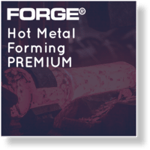 FORGE® Hot Metal Forming PREMIUM gives access to all the functionalities described in the ESSENTIAL module with additional attractive features related to hot forming processes. It is designed for process engineers and specialists eager to complete a deeper process analysis with special interest into tooling lifetime or raw material cost optimization.
FORGE® Hot Metal Forming PREMIUM gives access to all the functionalities described in the ESSENTIAL module with additional attractive features related to hot forming processes. It is designed for process engineers and specialists eager to complete a deeper process analysis with special interest into tooling lifetime or raw material cost optimization.
What's inside?
☑ Hot forging
☑ Warm forging
☑ Closed-die forging
☑ Hammer forging
☑ Bar shearing
☑ Flash trimming
☑ Preforming (reducer rolling, cross wedge rolling)
☑ Flat/Long product rolling
☑ Open-die forging
☑ Multi-Pass Files
☑ Rigid tooling
☑ Deformable tooling
☑ Die stress analysis (uncoupled approach)
☑ Die stress analysis (fully coupled approach)
☑ Optimization and inverse analysis
☑ Self-coding of user routines
☑ Material database for hot/warm forging
Key Advantages
All options included in FORGE® Hot Metal Forming ESSENTIAL and a selection of additional features:
- Ability to combine all simulations within the same computation chain
- Batch manager capability to launch a series of simulations one after the other
- User-friendly interface with dedicated templates for the forging industry
- Access to a wide variety of forging equipment: hydraulic press, crank press, drop hammer, counterblow hammer, etc.
- Fully automatic and highly adaptive mesh generator
- Automatic report generator
- High parallel scalability (efficiency based on multiple computational cores) for optimal CPU time speedup
- A robust FEM solver delivering highly reliable results
- Exhaustive material database with more than 800 materials specifically characterized for hot forming processes
- Full compatibility with JMatPro® material software
- Grain flow representation within the part, thanks to our efficient marking grid technique. Marking grids are used to track and locate sensitive areas such as sheared billet surfaces or centerline segregation. This technique can also be used to detect folds, laps and flow-through defects
- Use of sensors to track material points, follow their displacement and record scalar information (temperature, strain, etc.). Sensors provide an understanding of the origin of an issue detected on the finished forged product
- Access to damage criteria to anticipate inner or surface cracks
- Tooling & Forging equipment analysis: tonnage, abrasion wear, stress and deflection obtained via uncoupled die analysis
- Microstructure analysis to calculate grain size and the recrystallized fraction for a selection of alloy steels and nickel-based alloys
- Extended list of forming processes
- The multi-pass file offers the advantage of simulating all forging process passes in a single calculation
- Deformable dies
- Multi-body and multi-material calculation
- Fully coupled die stress analysis including thermal steady-state computation predicting the number of cycles to failure
- Temperature dependency for the abrasion wear model
- Rolling process simulation based on an incremental or steady-state method
- Automatic optimization (e.g. applicable to yield improvement)
- DOE (Design of Experiment) capability
- Self-coding of user subroutines
Your benefits
➽ Simulation of additional forming processes such as flat/long product rolling, open-die forging, cogging, becking and mandrel drawing
➽ It can be used with a multi-pass file (MPFx), a simple and clever way to define a series of repetitive motions (or kinematics) applied to the billet or to the dies (e.g. application to a round-oval-round breakdown sequence in open-die forging).
➽ Perform a fully coupled die stress analysis to calculate all interactions between the workpiece and tooling at any step of the computation. Therefore, temperature, deflection or stress variations occurring in the dies are accurately modeled. This is also applicable to more complex tooling with multiple inserts or die cases.
➽ Use of the automatic optimization feature to improve existing processes in various ways (e.g. get optimal preform shape or billet cut weight to increase the yield and make significant savings on material costs). The same technique is used to setup DOEs and make process parameter identification by inverse analysis.
➽ Take advantage of User Fortran subroutines to code your own variables such as a damage criterion and/or to enrich its simulation thanks to the implementation of new models (material behavior, friction or heat transfer coefficient, etc.).
Would you like to receive information about other module offers?





